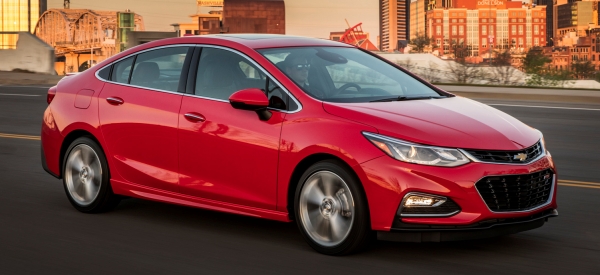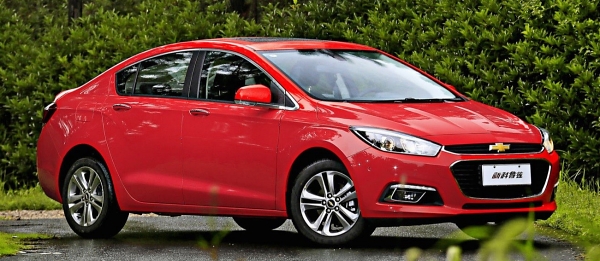|
|
|
| Published
on 3
Jun
2016 |
All rights reserved.
|
|
|

US
version Cruze
|
The
first generation Chevrolet Cruze was a breakthrough. It was the first
truly global product for the American brand,
being sold in not only America but also Europe, China, Korea, Australia
(okay, under the name of Holden) and many other places. GM set an
ambitious sales
target of 1 million units annually. It didn’t quite meet that target,
but it managed a respectable 700,000 units at its peak and eventually
more than 3 million copies over its lifespan. Having tasted the first
success, GM wants to go a step further with the second generation.
Although Chevrolet is no longer marketed in Europe, the growth in China
and Americas could easily absorb the losses, thus the new Cruze has
potential to better its predecessor. This time around, GM upgraded its
effort by reshuffling its development task. While the Mk1 was developed
by GM Daewoo in South Korea, the Mk2 has most of its engineering work
led by its European operation, i.e. Opel, in Germany.
GM never said so openly (the official tag line is always “developed by
GM’s global R&D team”), but in an engineering seminar taken place
in Germany 2 years ago, the engineering details of the new car was
revealed, and it was known the high-strength steel chassis was
developed in Germany. No wonder the car was caught testing many times
at Nurburgring.
However, the styling and packaging of the car are likely to be
responsible by the design and engineering staffs of local divisions.
Take the American version for example, its bold, Malibu-style front end
can be designed by only American, isn't it? Meanwhile, the more civilized look of
the Chinese
version pictured below is more likely to come from the Shanghai studio
(alright, purely my guess). Both cars share the same sleek profile
which achieves a good Cd of 0.29. The Chinese car has a shorter, 2662
mm wheelbase against the American car’s 2700 mm. Thanks to the longer
wheelbase, the American car is claimed to offer 50 mm more rear knee
room than the last generation.

Chinese
version Cruze
|
Regardless
of version, the Cruze is built upon the Opel-designed D2XX platform,
which also serves the latest Opel Astra. 72 percent of its monocoque
body is made of high-strength steel, compared with 58 percent of the
old
car or 53 percent of the latest Hyundai Elantra. Besides, another 3
percent is aluminum content. The rigidity of
body-in-white is increased by 27 percent, while weight is down by 52
kg. Meanwhile, equal effort has been spent to trim weight from other
major components. For example, the new 6-speed automatic transmission
is 11
kg lighter than before, while the all-alloy 1.4 turbo engine is 20 kg
lighter than its iron-block predecessor. Overall, the whole car is said
to be 113 kg lighter.
Having said that, the Chevy is still 100 kg or so heavier than its
European cousin. Why? Because it has more weight spent to the sedan
boot as well as more sound deadening materials. While the Astra is not
quite the most refined European hatchback, the American Cruze is
probably the quietest compact you can buy in America, more so than the
new Honda Civic. The Chinese version isn’t as good in this respect
because it was hurried to the market in early 2015. The American
version wisely spent an extra year to improve its NVH suppression and
ride composure, which is evident in the real world driving.
On the
downside, neither version feels as agile as the lighter Astra. The
Chinese Cruze and the premium models of American Cruze ride on
torsion-beam plus Watts link at the rear axle like Opel, but their
suspension tuning is slightly softer. While grip is abundant and body
movement is well controlled, the light steering is not as responsive or
as engaging. The loose gearchange of the manual gearbox also hampers
its driving pleasure. The car is more about refinement, safe and
predictable handling.
Lesser models of the American Cruze, which are expected to account for
the majority of sales there, skip Watts linkage in the rear suspension
in a
bid to save cost, so their body control is looser still. Predictably,
their suspension and steering tuning and tire choices are biased further towards the
comfort side, which is admittedly good news to average buyers. All in
all, keen drivers would find more driving pleasure on Mazda3, Ford
Focus, Volkswagen Golf or Honda Civic.
On more challenging roads, the multi-link camp rivals would also
display more ride composure, whereas the less sophisticated suspension
of Chevrolet just bottoms and bounces on large bumps. Nevertheless, on
normal roads its rigid chassis and remarkable NVH engineering can more
than make up for the weaker suspension design.
The new 1.4 Ecotec turbo engine is also developed in Rüsselsheim
and shared with Opel Astra. This all-aluminum unit is served with
up-to-date technology like dual-VVT, direct injection, hollow
crankshaft,
integrated exhaust manifold, variable oil pump and automatic
stop-start. It produces 153 horsepower and 177 pound-foot of torque,
sufficient to propel the car from zero to 60 mph in less than 8 seconds
no matter with 6-speed manual or 6-speed automatic transmission mated.
Being
a downsized turbo engine, its throttle response is inevitably a bit
soft at low rev, but the power delivery is smooth and linear. It feels
quite gusty from 2000 rpm upward, giving the Cruze a brisk feel in
most situations and easier overtaking. Fuel economy is also remarkable
in the real world.
Admittedly, part of the fuel economy gain is down to gearing. The
6-speed automatic transmission on the American car is tuned for fuel
economy, so it tends to upshift early and keep rev low. This also
lowers engine noise and boosts cruising refinement. The Chinese car
employs a 7-speed dual-clutch instead, but its shift pattern is
similarly biased towards higher gears. Moreover, its gearshifts are
pretty slow. Not a world-class DCT.
Apart from ride refinement and engine, another strength of Cruze is
design. Both versions are stylish enough to be ranked quite high in the
class, but the American car has more character thanks to its sharper
front end and the availability of 18-inch wheels (though so equipped
will downgrade ride quality somewhat). The fast roof line is not unlike
Hyundai Elantra or Honda Civic, but the Chevy looks sleeker than both,
almost like Volt. On the flipside, the drawback is reduced headroom for
rear passengers. It can marginally fit a 5 ft 11 guy under the sloping
roof, although the long wheelbase of the American car offers very good
legroom (the Chinese car is much tighter, but still enough for that 5
ft 11 guy). Up front, space is more generous. The driving environment
is pretty light and airy as the fast windscreen has its base pushed
forward thus result in a stronger sense of spaciousness. The dashboard
design is up to date, if not especially tasteful or upmarket. The
materials and build quality are competitive without being outstanding.
The MyLink infotainment system and its touchscreen are easy to use.
Overall, the new Cruze is competitive in the class, especially for
those not seeking driving thrills. It is not good enough to stand out
from the crowd though. There are quite some cars better to drive, some
roomier and some better built. However, it has no
particular weakness either, so its success or not will depend very much
on pricing, marketing and whether people like its bold new look.
|
Verdict:    |
|
|
|
|
|
|
|
|
|
|
Cruze (China)
|
2015
|
| Front-engined,
FWD |
| Steel monocoque |
Mainly steel
|
| 4567 / 1786 / 1454 mm |
| 2662 mm |
Inline-4
|
| 1399 cc |
DOHC 16 valves, DVVT
|
Turbo
|
| DI |
150 hp
|
173 lbft
|
7-speed twin-clutch
|
F: strut
R: torsion-beam, Watts link
|
| - |
205/55R16
|
1300 kg
|
130 mph (est)
|
8.0 (est)
|
-
|
|
Cruze (US)
|
2016
|
| Front-engined,
FWD |
| Steel monocoque |
Mainly steel
|
| 4665 / 1795 / 1460 mm |
| 2700 mm |
Inline-4
|
| 1399 cc |
DOHC 16 valves, DVVT
|
Turbo
|
| DI |
153 hp
|
177 lbft
|
6-speed automatic
|
F: strut
R: torsion-beam
|
| - |
205/55R16
|
1330 kg
|
132 mph (c)
|
7.6*
|
21.6*
|
|
|
|
|
|
|
Performance
tested by: *C&D
|
|
|
|
|
|
|
|
|
Copyright©
1997-2016
by Mark Wan @ AutoZine
|
|